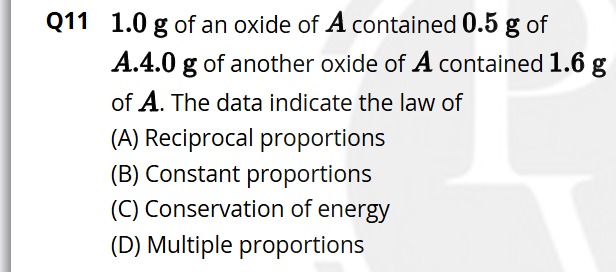Question
Question: 1.0 g of an oxide of $A$ contained 0.5 g of $A$.4.0 g of another oxide of $A$ contained 1.6 g of $A$...
1.0 g of an oxide of A contained 0.5 g of A.4.0 g of another oxide of A contained 1.6 g of A. The data indicate the law of

Reciprocal proportions
Constant proportions
Conservation of energy
Multiple proportions
Multiple proportions
Solution
Let's analyze the composition of the two oxides of element A.
Oxide 1:
Total mass = 1.0 g Mass of A = 0.5 g Mass of oxygen = Total mass - Mass of A = 1.0 g - 0.5 g = 0.5 g
Ratio of mass of A to mass of oxygen in Oxide 1 = Mass of oxygenMass of A=0.5 g0.5 g=11
Oxide 2:
Total mass = 4.0 g Mass of A = 1.6 g Mass of oxygen = Total mass - Mass of A = 4.0 g - 1.6 g = 2.4 g
Ratio of mass of A to mass of oxygen in Oxide 2 = Mass of oxygenMass of A=2.4 g1.6 g=2416=32
We observe that the ratio of A to oxygen is different in the two oxides (1:1 vs 2:3), indicating that these are two different compounds formed by the same two elements, A and oxygen.
To determine which law is indicated, let's consider the mass of oxygen that combines with a fixed mass of A. Let's fix the mass of A at 1 g.
In Oxide 1:
- 5 g of A combines with 0.5 g of oxygen. So, 1 g of A combines with 0.5 g0.5 g×1 g=1 g of oxygen.
In Oxide 2:
- 6 g of A combines with 2.4 g of oxygen. So, 1 g of A combines with 1.6 g2.4 g×1 g=1624 g=23 g=1.5 g of oxygen.
Now, let's find the ratio of the masses of oxygen that combine with the fixed mass of A (1 g) in the two oxides: Ratio of masses of oxygen = (Mass of oxygen in Oxide 1) : (Mass of oxygen in Oxide 2) Ratio = 1 g : 1.5 g = 1 : 1.5 = 1 : 23 = 2 : 3
The ratio of the masses of oxygen that combine with a fixed mass of A (1 g) in the two oxides is 2:3, which is a simple whole number ratio.
According to the Law of Multiple Proportions, when two elements combine to form more than one compound, the different masses of one element that combine with a fixed mass of the other element are in a simple whole number ratio.
This is exactly what the data shows for the two oxides of A.
(A) Reciprocal proportions: This law involves three elements. The data involves only two elements (A and O). (B) Constant proportions: This law states that a given chemical compound always contains the same elements in the same proportion by mass. The data shows two different oxides with different compositions, so this law applies to each oxide individually but the data as a whole illustrates the relationship between multiple compounds formed by the same elements. (C) Conservation of energy: This law is related to energy transformations, not mass ratios in compounds. (D) Multiple proportions: This law describes the relationship between the compositions of multiple compounds formed by the same two elements, which matches our observation.
Thus, the data indicates the law of multiple proportions.
